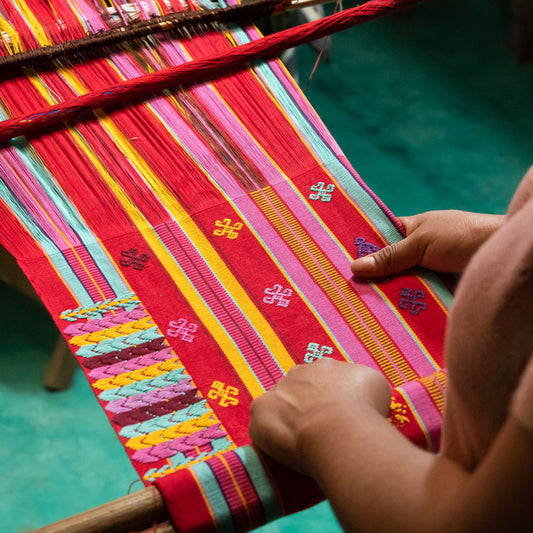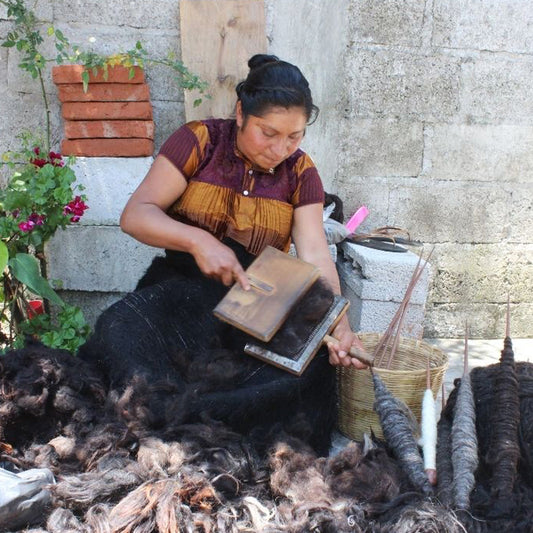Jonathan is the founder of the Ghanaian homeware brand, Boon & Up. He was volunteering in far northern Ghana when he first came upon the Dagaaba women and their beautiful weaving techniques. Using his background in art, Jonathan set up Boon & Up to create employment opportunities for the women who struggling in the face of climate change.
In this interview, Jonathan talks about the incredible weavers behind the brand, how rural Ghanaian communities are adapting in unpredictable weather patterns, and shares with the AKOJO community his top tips for travelling in Ghana. Boon & Up is a collection of beautiful homeware projects, lovingly woven by women from the Dagaare region in northern Ghana. 20% of all profits are returned to the community to fund projects that create further employment opportunities.
Can you tell us about your background and the origins for Boon and Up?
To be honest, I’m a little uncomfortable talking about myself in this context. I think the focus should perhaps be on the weavers? Boon & Up represent a collective of thirty women in Lawra in rural far north of Ghana who weave cotton fabric by the metre on traditional narrow two-shaft looms. They live close to the border with Burkina Faso, in a small town that’s a 16 hour bus trip to the nearest airport. Traditionally, the fabric they weave is cut into strips and sewn to make traditional smocks that are worn by men and women across northern Ghana. However, harsh changes in the climate of northern Ghana have led to an ongoing impoverishment of the region and demand for smocks has fallen. So Boon & Up was established to find a market for the weavers in the UK. The weavers adapted their looms to create wider fabric that is up to 110cm in width, in order to make it more suitable for overseas consumers.
All our weavers belong to the Dagaaba tribe and were born and grew up in Lawra. On a map the Dagaaba people are spread across an oval 60 miles wide that stretches across north west Ghana and south west Burkina Faso and is bisected by the Volta river. The weavers live in square mud houses close to the town and they either walk or cycle to our weaving workshop. Some will take three hours to walk to the workshop, but most live a little closer than that. Most live without electricity, and they fetch water for drinking, washing and cooking from boreholes near to their houses. They eat food that’s made mainly from millet or cassava which they pound using large wooden pestle and mortars, and then add perhaps groundnuts and vegetables. Food is cooked over an open fire and eaten once or twice a day.
Your designs are a blend of traditional techniques and contemporary design. How do you manage to stay authentic to tradition whilst meeting modern market tastes?
In decades gone past, a limited number of patterns were used, the most popular based on the plumage of the Guineafowl. But more recently, the weavers have expanded the number of patterns used as fashions in Ghana change. The weavers now refer to a fabric book of forty different traditional patterns for their inspiration, and Boon & Up has dyed the cotton yarn the colours that the Dagaaba people paint their houses. Boon & Up have also adapted their traditional blanket looms so they can create rugs. Their sister seamstresses take the cloth and make throws, blankets and cushion covers, and embroiderers then add further embellishments. The highly coloured patterns that the weavers traditionally weave respond well to the very strong sunlight in north Ghana, Boon & Up tweaked the colours to make fabric that is more suitable for our climate. The weavers also have adapted their methods slightly to create softer fabric than their norm.
"Harsh changes in the climate of northern Ghana have led to an ongoing impoverishment of the region and demand for smocks has fallen. So Boon & Up was established to find a market for the weavers in the UK."
Boon and Up provides a sustainable source of income for Dagaaba women weavers in North Ghana, a region that has been hit by the ill-effects of climate change. What challenges are local communities facing and what role does adaptation play in mitigating these challenges?
As the climate changes and the rain patterns become irregular, the local farmers try to adapt as best they can. They try different crops, different seed varieties, they build low mud walls around their small fields to retain the rainfall, they use boreholes to irrigate during the long dry seasons. Many will move off the land to try their luck in the south of Ghana, although their lack of good English will hamper their chances.
Do you have any travel tips for Ghana?
Head out of Accra (as soon as possible!) and go west to Cape Coast, Elmina and the stunning beaches all the way up to the border with Ivory Coast. Visit one of the castles along the way; visceral reminders of the total inhumanity of the slave trade. Hang out at Big Milly’s Backyard in Kokrobite with all the NGO staffers on weekend breaks. Try eating fufu, and banku with light soup; traditional fermented Ghanaian food that’s an ‘acquired taste’. Go north to Mole National Park to see wildlife including elephants at a tenth of the price of East Africa. Take a tro tro (minivan bus) to get around and understand what a sardine must feel like.
Featuring beautiful blankets and soft furnishings handwoven by the women of the Dagaaba tribe. The pieces are made using cotton grown by smallholder African farmers under the ‘Cotton made in Africa’ initiative.






